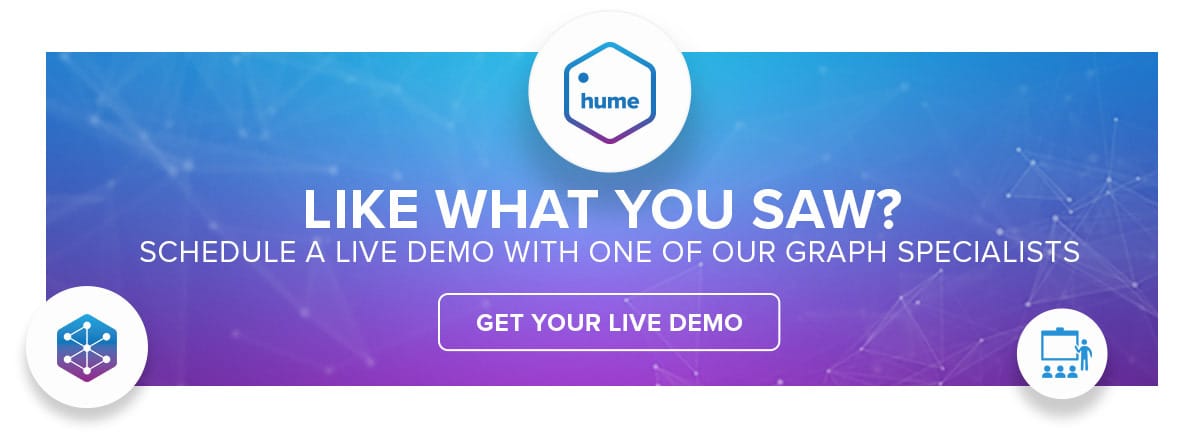We are proud to announce the 2.11 release of Hume. Advanced Expand is introduced to Hume with this release, which lets users create complex queries to navigate the graph without using Cypher. Additionally, the visibility of Actions can now be defined per Perspectives, enabling a tailored exploration experience; a GraphQL API exposes data from Perspectives so that other apps can leverage the power of Hume. And finally, Configuration-as-Code allows administrators to manage Hume configuration files in a repository.
In Hume 2.11 you can:
- Traverse the graph without using Cypher with Advanced Expand.
- Tailor the availability of Actions for each Perspective.
- Expose data from Perspectives via a GraphQL API to other apps.
- Manage your Hume configuration in a repository with Configuration-as-Code.
Explore the graph without using a query language
Our new Advanced Expand, makes it possible to build a navigation path through the graph visually, without using a graph query language. You simply select a node as a starting point and then add the related items that you would like to explore. In order to get specific results, filters can be applied. This opens a new depth to the explorations of analysts and investigators that do not use Cypher.
This video shows how Advanced Expand is used to build an exploration path, filter the results, and see the Hume Visualisation canvas results.
Tailor the analysis experience by customising the visibility of Actions to each Perspective
Hume Perspectives lets you tailor a specific view on the schema and, through this, the data in Neo4j. This adds an extra layer of security and enables analysts and investigators to work only on relevant data, undisturbed by irrelevant items. With 2.11, the visibility of Actions can be customised per Perspectives, making it possible to tailor their usage to the view of schema that each Perspective offers.
This way, analysts and investigators have the right Actions at hand, at any time.
In this video, you can see how an Action is assigned to a Perspective and how an analyst can choose the Action when using a specific Perspective.
With 2.11 we release two groundbreaking features as Beta versions, so you can try them out and give us early feedback.
Beta: Expose data from Hume Perspectives to other apps
Our new GraphQL API makes it possible to expose data from Hume Perspectives to other apps. In this way the Schema, Nodes, Relationships & Virtual Relationships, and Actions can be exposed to 3rd party applications.
Beta: Configuration-as-Code
With Configuration-as-Code, a system administrator can manage Hume’s configuration as configuration resources in their source repository. It lets them treat application configuration resources as versioned artifacts. It is possible to configure new instances of Hume or manage existing ones. This enables much faster and more efficient configuration management and versioning of configurations.
Further improvements
Along with major changes, each release comes with improvements, bug fixes, and minor updates. Some of these include:
- Network attributes in Styles: Badges now support network attributes such as degree and weighted degree. This makes it possible to use the full power of Hume Styles to understand the network centrality of nodes.
- Polygons in Geospatial Analysis: You can now draw polygons in geospatial analysis which makes it possible to understand the locations of data points in the drawn area. Geospatial Data layers are Hume actions that can return GEOSPATIAL data elements (points, or polygons) to be plotted on the map alongside normal graph data. This is useful in many scenarios, e.g. to show auxiliary data on the map nearby the graph entities, such as CCTV locations when investigating a crime.

Supercharge Hume’s UX
As part of Hume’s development, we want to evaluate new features and ideas with users constantly. If you are interested in joining a usability test and evaluating what we are working on, please contact us.
Further sources of knowledge
If you’re interested in learning more about how Hume delivers high value solutions, these resources give an overview of the range of possibilities.
Read more about Hume features of Actions and Temporal and Geospatial Analysis.
Don’t miss part 2 of our engineering series about microservices.
Read about how Hume can help you detect fraud.
And if you are one of us music lovers, don’t forget to watch the recording from the Neo4j Event: A Music Knowledge Graph with GraphAware.

